Exploring Smart Home Automation: A Detailed Literature Review
VerifiedAdded on 2023/06/12
|18
|3518
|284
Literature Review
AI Summary
This literature review provides an overview of various smart home automation systems, including central controller-based, Bluetooth-based, GSM-based, SMS-based, Raspberry Pi-based, IoT-based, cloud-based, Android ADK-based, ZigBee-based, radio frequency-based, and microcomputer-based systems. It discusses the advantages and disadvantages of each approach, highlighting challenges such as inflexibility, poor manageability, security concerns, and high costs. The review emphasizes the importance of cost-effectiveness and low energy consumption in smart home implementation and notes the trend towards bidirectional communication using Home Automation Networks, including feedback and energy rating facilities. Ultimately, this survey acts as a guide for users in choosing the right smart home technology based on their specific requirements.
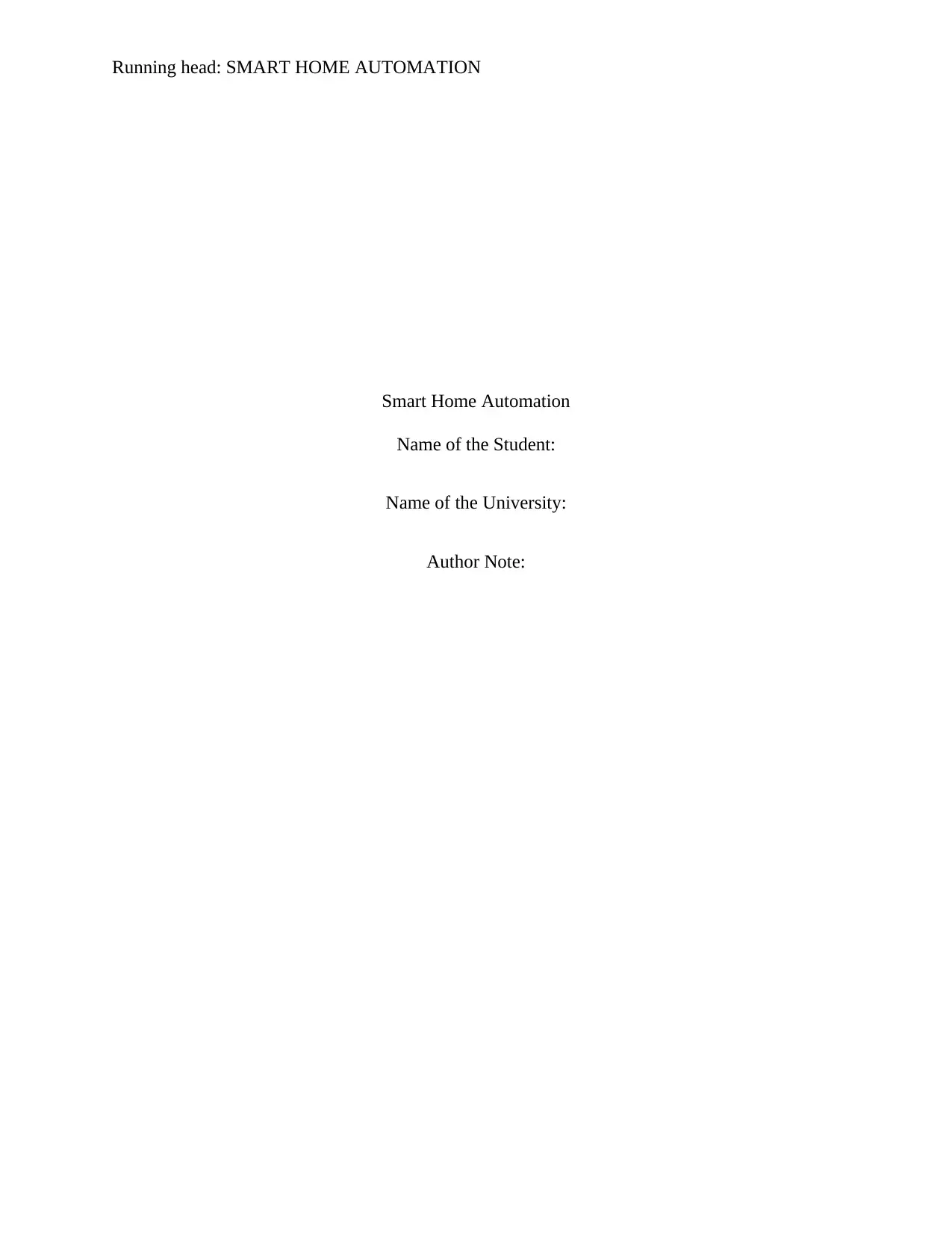
Running head: SMART HOME AUTOMATION
Smart Home Automation
Name of the Student:
Name of the University:
Author Note:
Smart Home Automation
Name of the Student:
Name of the University:
Author Note:
Paraphrase This Document
Need a fresh take? Get an instant paraphrase of this document with our AI Paraphraser
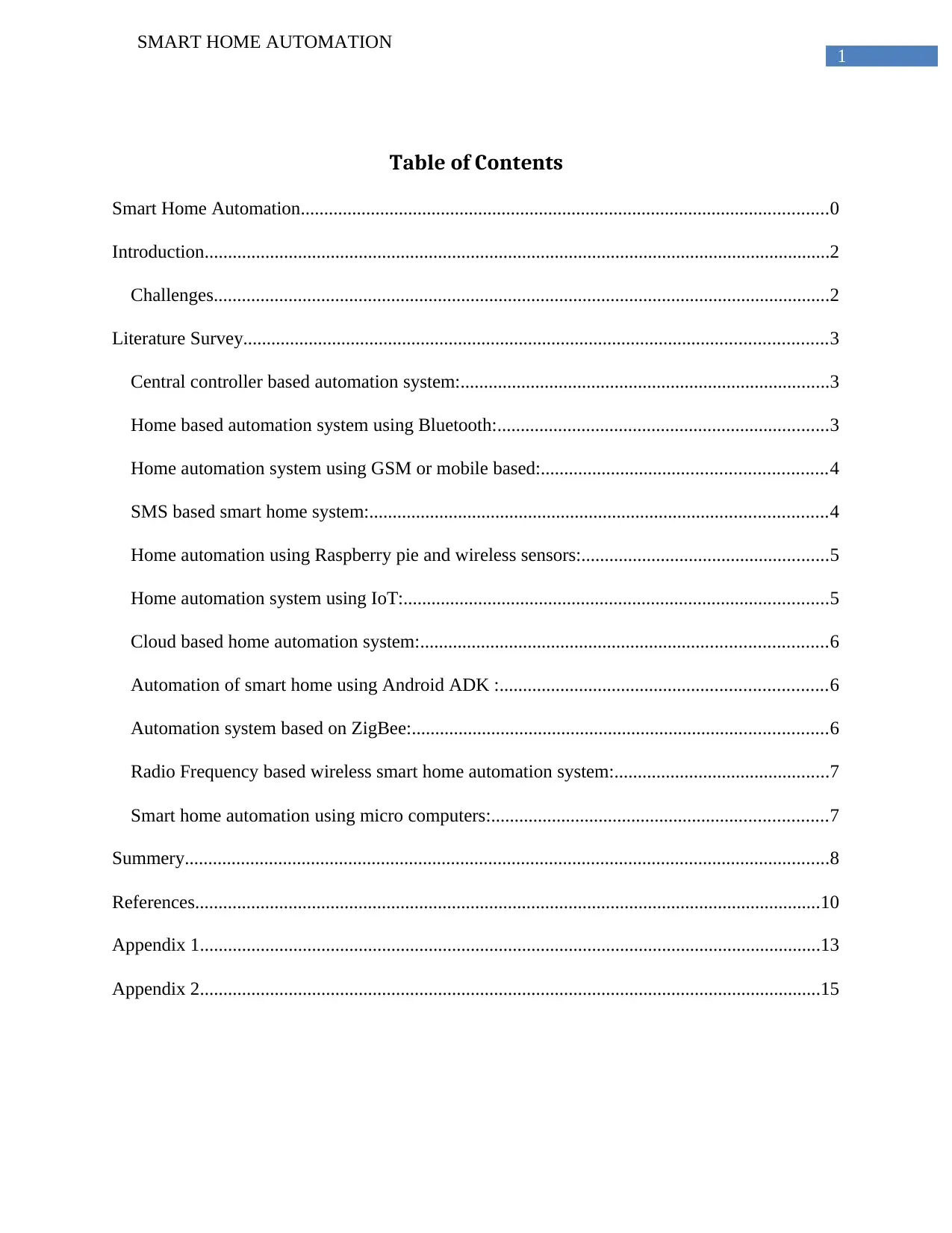
1
SMART HOME AUTOMATION
Table of Contents
Smart Home Automation.................................................................................................................0
Introduction......................................................................................................................................2
Challenges....................................................................................................................................2
Literature Survey.............................................................................................................................3
Central controller based automation system:...............................................................................3
Home based automation system using Bluetooth:.......................................................................3
Home automation system using GSM or mobile based:.............................................................4
SMS based smart home system:..................................................................................................4
Home automation using Raspberry pie and wireless sensors:.....................................................5
Home automation system using IoT:...........................................................................................5
Cloud based home automation system:.......................................................................................6
Automation of smart home using Android ADK :......................................................................6
Automation system based on ZigBee:.........................................................................................6
Radio Frequency based wireless smart home automation system:..............................................7
Smart home automation using micro computers:........................................................................7
Summery..........................................................................................................................................8
References......................................................................................................................................10
Appendix 1.....................................................................................................................................13
Appendix 2.....................................................................................................................................15
SMART HOME AUTOMATION
Table of Contents
Smart Home Automation.................................................................................................................0
Introduction......................................................................................................................................2
Challenges....................................................................................................................................2
Literature Survey.............................................................................................................................3
Central controller based automation system:...............................................................................3
Home based automation system using Bluetooth:.......................................................................3
Home automation system using GSM or mobile based:.............................................................4
SMS based smart home system:..................................................................................................4
Home automation using Raspberry pie and wireless sensors:.....................................................5
Home automation system using IoT:...........................................................................................5
Cloud based home automation system:.......................................................................................6
Automation of smart home using Android ADK :......................................................................6
Automation system based on ZigBee:.........................................................................................6
Radio Frequency based wireless smart home automation system:..............................................7
Smart home automation using micro computers:........................................................................7
Summery..........................................................................................................................................8
References......................................................................................................................................10
Appendix 1.....................................................................................................................................13
Appendix 2.....................................................................................................................................15

2
SMART HOME AUTOMATION
SMART HOME AUTOMATION
⊘ This is a preview!⊘
Do you want full access?
Subscribe today to unlock all pages.

Trusted by 1+ million students worldwide
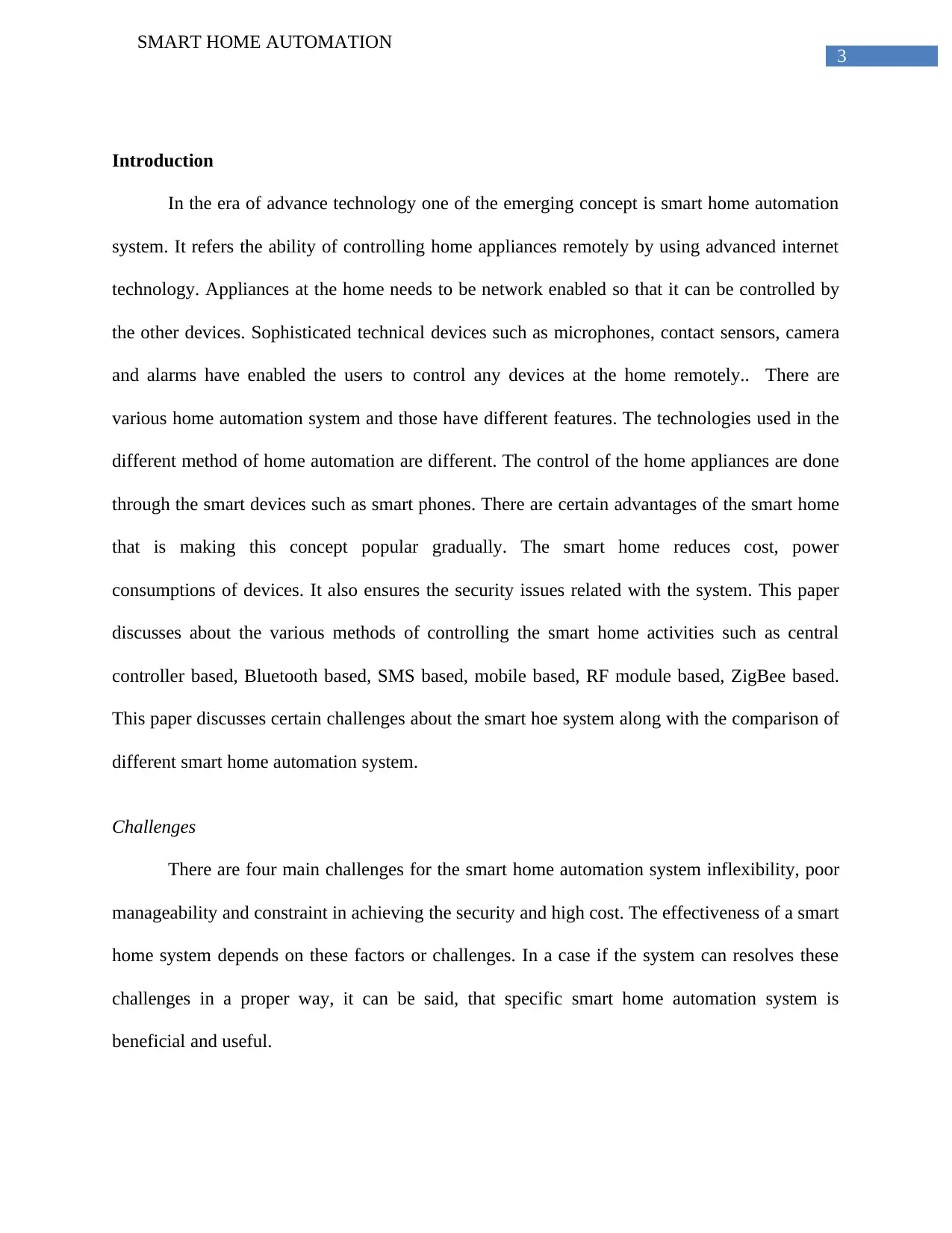
3
SMART HOME AUTOMATION
Introduction
In the era of advance technology one of the emerging concept is smart home automation
system. It refers the ability of controlling home appliances remotely by using advanced internet
technology. Appliances at the home needs to be network enabled so that it can be controlled by
the other devices. Sophisticated technical devices such as microphones, contact sensors, camera
and alarms have enabled the users to control any devices at the home remotely.. There are
various home automation system and those have different features. The technologies used in the
different method of home automation are different. The control of the home appliances are done
through the smart devices such as smart phones. There are certain advantages of the smart home
that is making this concept popular gradually. The smart home reduces cost, power
consumptions of devices. It also ensures the security issues related with the system. This paper
discusses about the various methods of controlling the smart home activities such as central
controller based, Bluetooth based, SMS based, mobile based, RF module based, ZigBee based.
This paper discusses certain challenges about the smart hoe system along with the comparison of
different smart home automation system.
Challenges
There are four main challenges for the smart home automation system inflexibility, poor
manageability and constraint in achieving the security and high cost. The effectiveness of a smart
home system depends on these factors or challenges. In a case if the system can resolves these
challenges in a proper way, it can be said, that specific smart home automation system is
beneficial and useful.
SMART HOME AUTOMATION
Introduction
In the era of advance technology one of the emerging concept is smart home automation
system. It refers the ability of controlling home appliances remotely by using advanced internet
technology. Appliances at the home needs to be network enabled so that it can be controlled by
the other devices. Sophisticated technical devices such as microphones, contact sensors, camera
and alarms have enabled the users to control any devices at the home remotely.. There are
various home automation system and those have different features. The technologies used in the
different method of home automation are different. The control of the home appliances are done
through the smart devices such as smart phones. There are certain advantages of the smart home
that is making this concept popular gradually. The smart home reduces cost, power
consumptions of devices. It also ensures the security issues related with the system. This paper
discusses about the various methods of controlling the smart home activities such as central
controller based, Bluetooth based, SMS based, mobile based, RF module based, ZigBee based.
This paper discusses certain challenges about the smart hoe system along with the comparison of
different smart home automation system.
Challenges
There are four main challenges for the smart home automation system inflexibility, poor
manageability and constraint in achieving the security and high cost. The effectiveness of a smart
home system depends on these factors or challenges. In a case if the system can resolves these
challenges in a proper way, it can be said, that specific smart home automation system is
beneficial and useful.
Paraphrase This Document
Need a fresh take? Get an instant paraphrase of this document with our AI Paraphraser
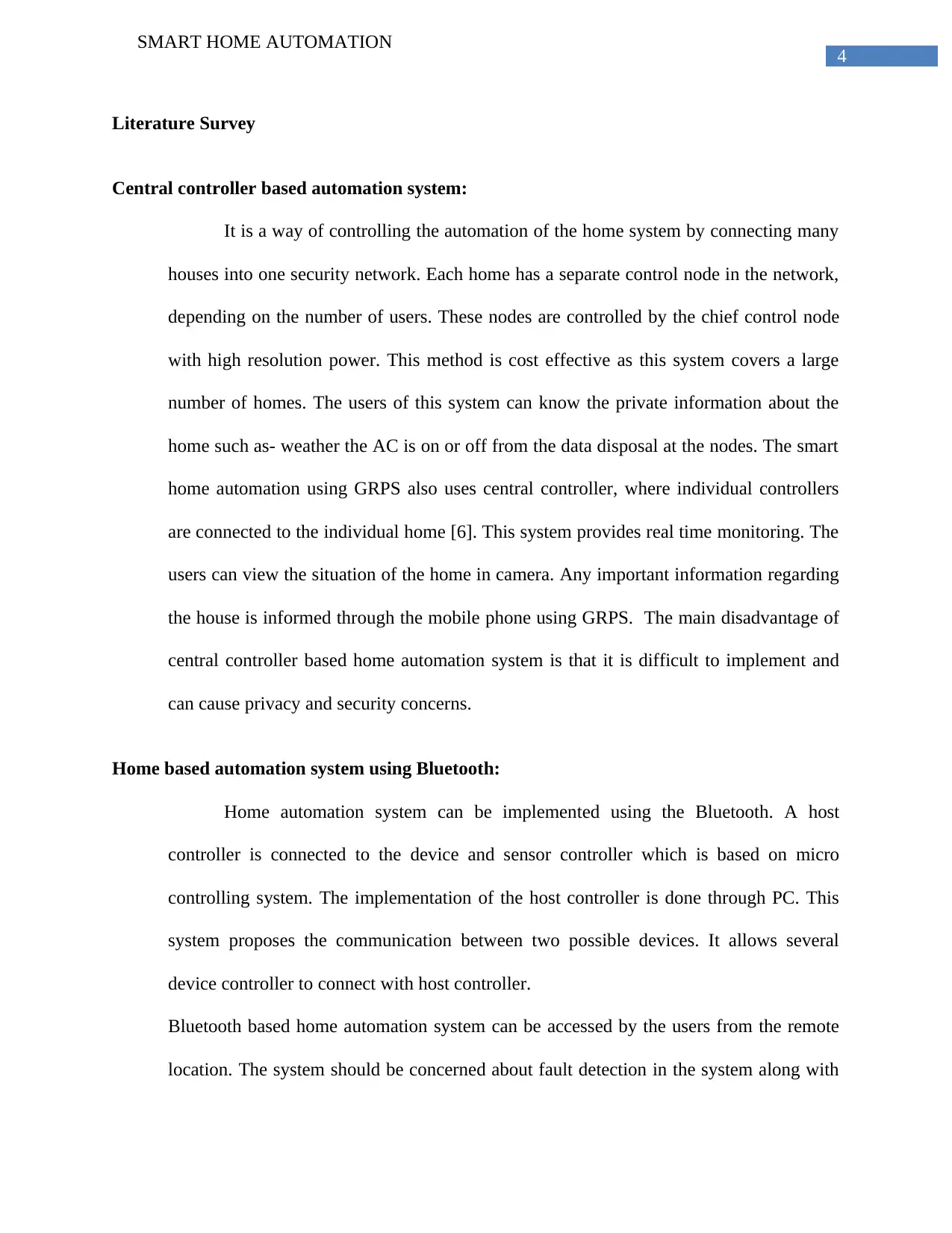
4
SMART HOME AUTOMATION
Literature Survey
Central controller based automation system:
It is a way of controlling the automation of the home system by connecting many
houses into one security network. Each home has a separate control node in the network,
depending on the number of users. These nodes are controlled by the chief control node
with high resolution power. This method is cost effective as this system covers a large
number of homes. The users of this system can know the private information about the
home such as- weather the AC is on or off from the data disposal at the nodes. The smart
home automation using GRPS also uses central controller, where individual controllers
are connected to the individual home [6]. This system provides real time monitoring. The
users can view the situation of the home in camera. Any important information regarding
the house is informed through the mobile phone using GRPS. The main disadvantage of
central controller based home automation system is that it is difficult to implement and
can cause privacy and security concerns.
Home based automation system using Bluetooth:
Home automation system can be implemented using the Bluetooth. A host
controller is connected to the device and sensor controller which is based on micro
controlling system. The implementation of the host controller is done through PC. This
system proposes the communication between two possible devices. It allows several
device controller to connect with host controller.
Bluetooth based home automation system can be accessed by the users from the remote
location. The system should be concerned about fault detection in the system along with
SMART HOME AUTOMATION
Literature Survey
Central controller based automation system:
It is a way of controlling the automation of the home system by connecting many
houses into one security network. Each home has a separate control node in the network,
depending on the number of users. These nodes are controlled by the chief control node
with high resolution power. This method is cost effective as this system covers a large
number of homes. The users of this system can know the private information about the
home such as- weather the AC is on or off from the data disposal at the nodes. The smart
home automation using GRPS also uses central controller, where individual controllers
are connected to the individual home [6]. This system provides real time monitoring. The
users can view the situation of the home in camera. Any important information regarding
the house is informed through the mobile phone using GRPS. The main disadvantage of
central controller based home automation system is that it is difficult to implement and
can cause privacy and security concerns.
Home based automation system using Bluetooth:
Home automation system can be implemented using the Bluetooth. A host
controller is connected to the device and sensor controller which is based on micro
controlling system. The implementation of the host controller is done through PC. This
system proposes the communication between two possible devices. It allows several
device controller to connect with host controller.
Bluetooth based home automation system can be accessed by the users from the remote
location. The system should be concerned about fault detection in the system along with

5
SMART HOME AUTOMATION
the control and update of the home appliances. There are certain issues about the
Bluetooth based home automation system. Bluetooth has a range of 100m, sometimes
more range is required. The communication requires high power consumptions
sometimes, the low encryption causes serious security concerns in the Bluetooth driven
technology.
Home automation system using GSM or mobile based:
This kind of smart home automation system is desirable to the researchers as use
of mobile phone is popular and GSM is an available technology. There are three methods
for the commitment of the communication in GSM- ‘SMS based home automation
system’, ‘GPRS based home automation system’ and ‘Dual Tone Multi Frequency based
home automation system’ [14]. In this case system uses transducer that helps to convert
machine instructions into electric signals. These electric signals go to the micro
controllers.
SMS based smart home system:
In SMS based smart home system, the signal detects the illegal entry at the
home and alerts the authorized users about the illegal intrudes at the house. In that
case, the system enables the option for the users to change the passkey for exiting
the home. The illegal intruder can be identified by monitoring door at the house.
The passkey of the door can be modified by the authorized users using keypad or
by the sending SMS through the registered number of the user. Apart from that
the users can control the lights and the heating system in the house by sending the
SMART HOME AUTOMATION
the control and update of the home appliances. There are certain issues about the
Bluetooth based home automation system. Bluetooth has a range of 100m, sometimes
more range is required. The communication requires high power consumptions
sometimes, the low encryption causes serious security concerns in the Bluetooth driven
technology.
Home automation system using GSM or mobile based:
This kind of smart home automation system is desirable to the researchers as use
of mobile phone is popular and GSM is an available technology. There are three methods
for the commitment of the communication in GSM- ‘SMS based home automation
system’, ‘GPRS based home automation system’ and ‘Dual Tone Multi Frequency based
home automation system’ [14]. In this case system uses transducer that helps to convert
machine instructions into electric signals. These electric signals go to the micro
controllers.
SMS based smart home system:
In SMS based smart home system, the signal detects the illegal entry at the
home and alerts the authorized users about the illegal intrudes at the house. In that
case, the system enables the option for the users to change the passkey for exiting
the home. The illegal intruder can be identified by monitoring door at the house.
The passkey of the door can be modified by the authorized users using keypad or
by the sending SMS through the registered number of the user. Apart from that
the users can control the lights and the heating system in the house by sending the
⊘ This is a preview!⊘
Do you want full access?
Subscribe today to unlock all pages.

Trusted by 1+ million students worldwide
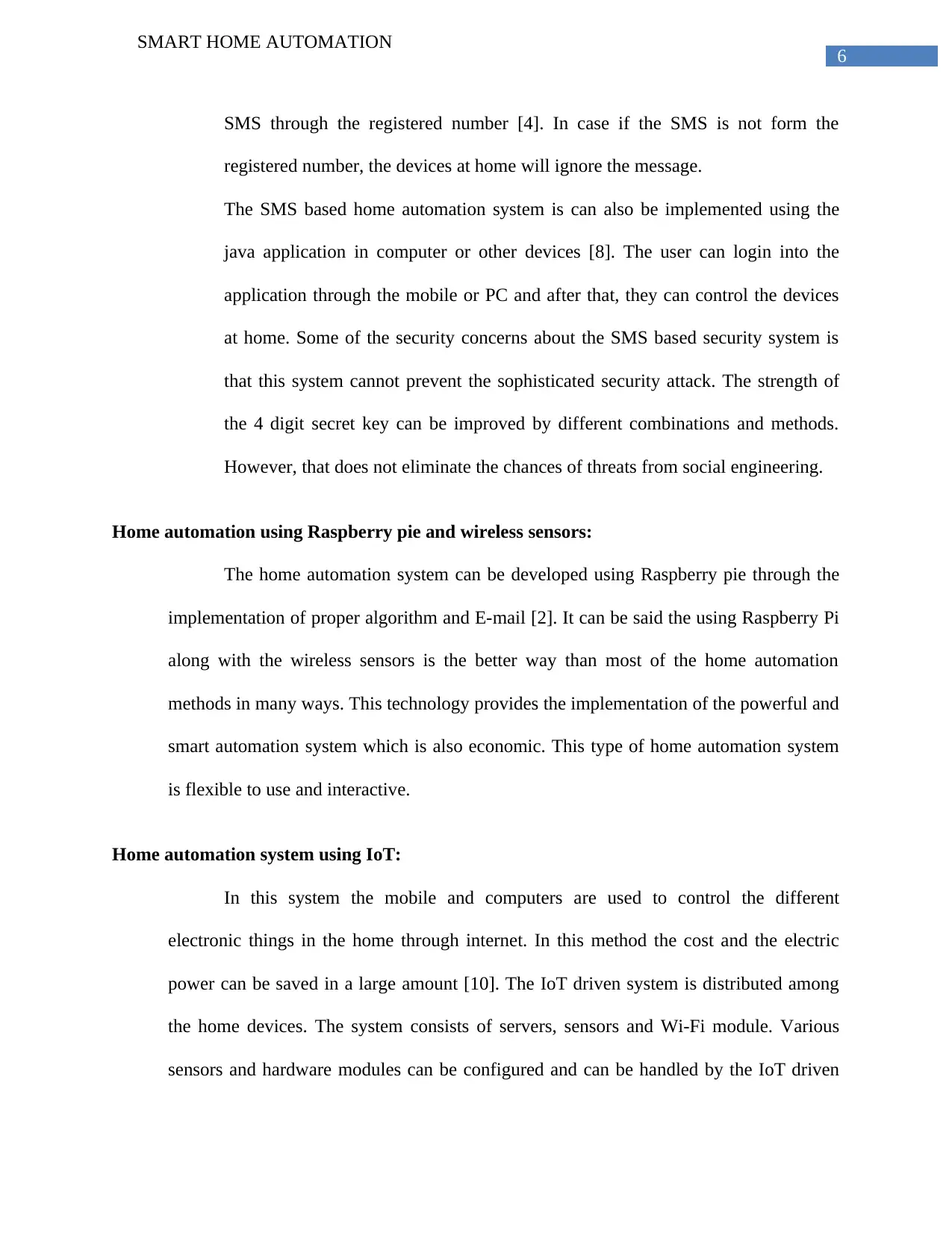
6
SMART HOME AUTOMATION
SMS through the registered number [4]. In case if the SMS is not form the
registered number, the devices at home will ignore the message.
The SMS based home automation system is can also be implemented using the
java application in computer or other devices [8]. The user can login into the
application through the mobile or PC and after that, they can control the devices
at home. Some of the security concerns about the SMS based security system is
that this system cannot prevent the sophisticated security attack. The strength of
the 4 digit secret key can be improved by different combinations and methods.
However, that does not eliminate the chances of threats from social engineering.
Home automation using Raspberry pie and wireless sensors:
The home automation system can be developed using Raspberry pie through the
implementation of proper algorithm and E-mail [2]. It can be said the using Raspberry Pi
along with the wireless sensors is the better way than most of the home automation
methods in many ways. This technology provides the implementation of the powerful and
smart automation system which is also economic. This type of home automation system
is flexible to use and interactive.
Home automation system using IoT:
In this system the mobile and computers are used to control the different
electronic things in the home through internet. In this method the cost and the electric
power can be saved in a large amount [10]. The IoT driven system is distributed among
the home devices. The system consists of servers, sensors and Wi-Fi module. Various
sensors and hardware modules can be configured and can be handled by the IoT driven
SMART HOME AUTOMATION
SMS through the registered number [4]. In case if the SMS is not form the
registered number, the devices at home will ignore the message.
The SMS based home automation system is can also be implemented using the
java application in computer or other devices [8]. The user can login into the
application through the mobile or PC and after that, they can control the devices
at home. Some of the security concerns about the SMS based security system is
that this system cannot prevent the sophisticated security attack. The strength of
the 4 digit secret key can be improved by different combinations and methods.
However, that does not eliminate the chances of threats from social engineering.
Home automation using Raspberry pie and wireless sensors:
The home automation system can be developed using Raspberry pie through the
implementation of proper algorithm and E-mail [2]. It can be said the using Raspberry Pi
along with the wireless sensors is the better way than most of the home automation
methods in many ways. This technology provides the implementation of the powerful and
smart automation system which is also economic. This type of home automation system
is flexible to use and interactive.
Home automation system using IoT:
In this system the mobile and computers are used to control the different
electronic things in the home through internet. In this method the cost and the electric
power can be saved in a large amount [10]. The IoT driven system is distributed among
the home devices. The system consists of servers, sensors and Wi-Fi module. Various
sensors and hardware modules can be configured and can be handled by the IoT driven
Paraphrase This Document
Need a fresh take? Get an instant paraphrase of this document with our AI Paraphraser
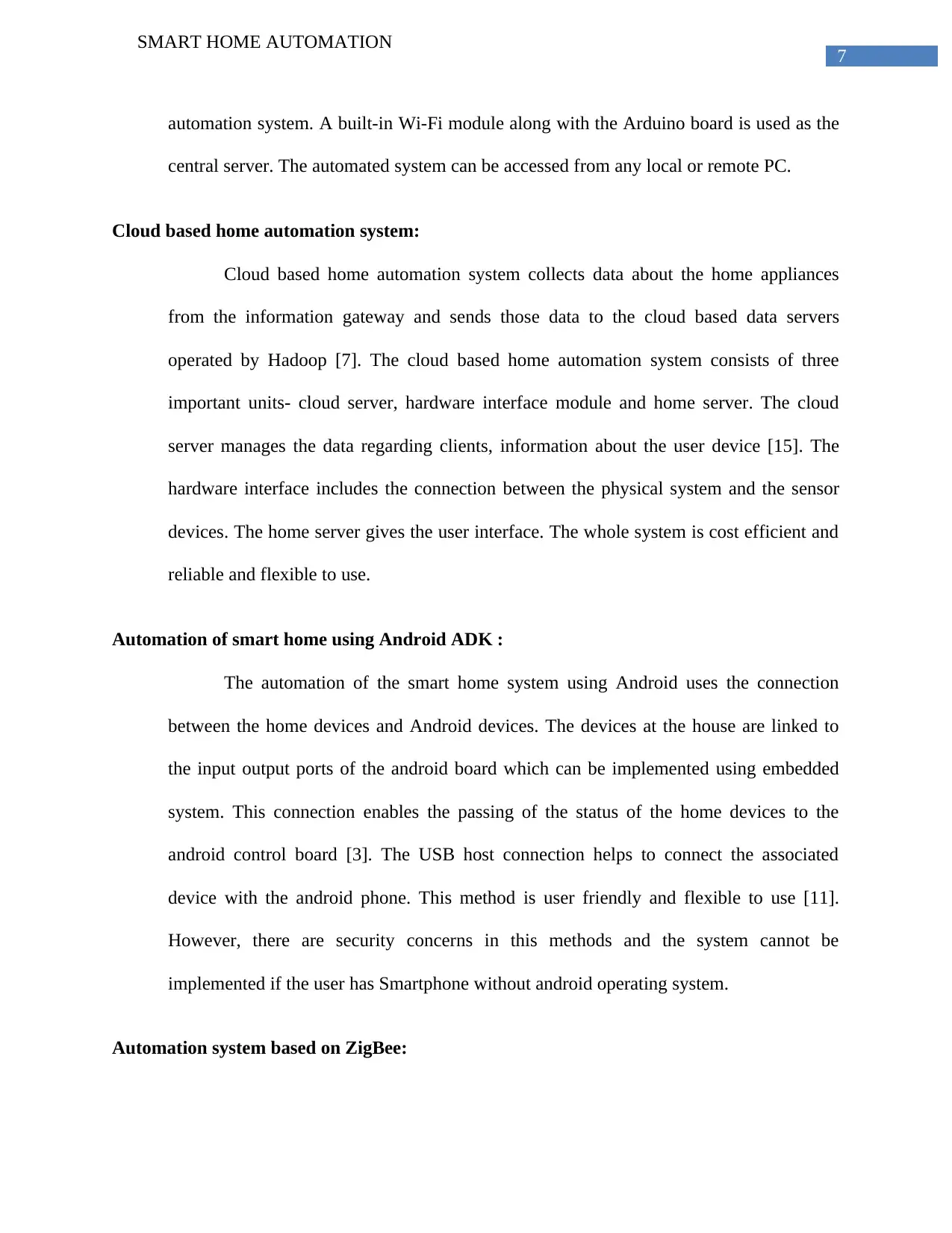
7
SMART HOME AUTOMATION
automation system. A built-in Wi-Fi module along with the Arduino board is used as the
central server. The automated system can be accessed from any local or remote PC.
Cloud based home automation system:
Cloud based home automation system collects data about the home appliances
from the information gateway and sends those data to the cloud based data servers
operated by Hadoop [7]. The cloud based home automation system consists of three
important units- cloud server, hardware interface module and home server. The cloud
server manages the data regarding clients, information about the user device [15]. The
hardware interface includes the connection between the physical system and the sensor
devices. The home server gives the user interface. The whole system is cost efficient and
reliable and flexible to use.
Automation of smart home using Android ADK :
The automation of the smart home system using Android uses the connection
between the home devices and Android devices. The devices at the house are linked to
the input output ports of the android board which can be implemented using embedded
system. This connection enables the passing of the status of the home devices to the
android control board [3]. The USB host connection helps to connect the associated
device with the android phone. This method is user friendly and flexible to use [11].
However, there are security concerns in this methods and the system cannot be
implemented if the user has Smartphone without android operating system.
Automation system based on ZigBee:
SMART HOME AUTOMATION
automation system. A built-in Wi-Fi module along with the Arduino board is used as the
central server. The automated system can be accessed from any local or remote PC.
Cloud based home automation system:
Cloud based home automation system collects data about the home appliances
from the information gateway and sends those data to the cloud based data servers
operated by Hadoop [7]. The cloud based home automation system consists of three
important units- cloud server, hardware interface module and home server. The cloud
server manages the data regarding clients, information about the user device [15]. The
hardware interface includes the connection between the physical system and the sensor
devices. The home server gives the user interface. The whole system is cost efficient and
reliable and flexible to use.
Automation of smart home using Android ADK :
The automation of the smart home system using Android uses the connection
between the home devices and Android devices. The devices at the house are linked to
the input output ports of the android board which can be implemented using embedded
system. This connection enables the passing of the status of the home devices to the
android control board [3]. The USB host connection helps to connect the associated
device with the android phone. This method is user friendly and flexible to use [11].
However, there are security concerns in this methods and the system cannot be
implemented if the user has Smartphone without android operating system.
Automation system based on ZigBee:
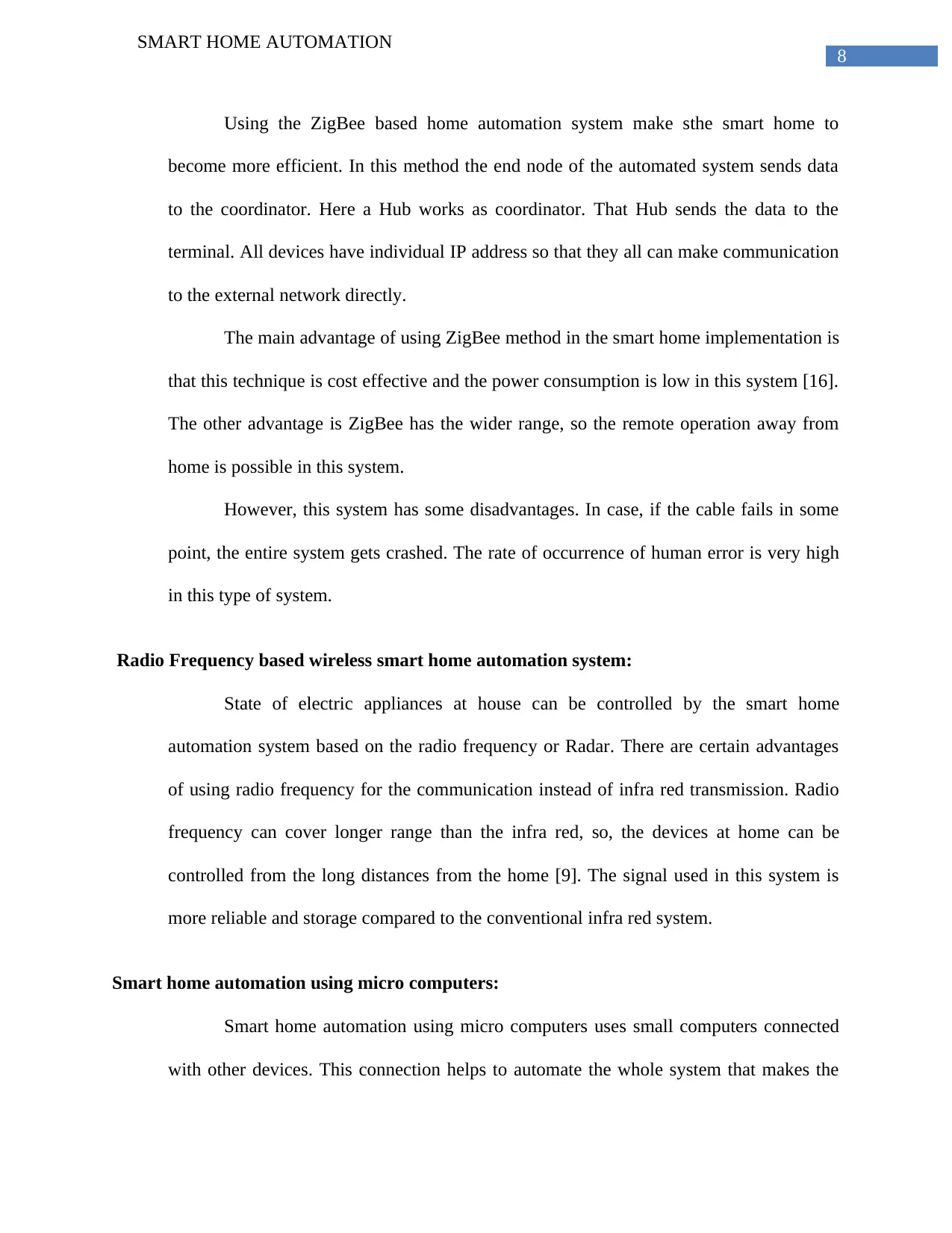
8
SMART HOME AUTOMATION
Using the ZigBee based home automation system make sthe smart home to
become more efficient. In this method the end node of the automated system sends data
to the coordinator. Here a Hub works as coordinator. That Hub sends the data to the
terminal. All devices have individual IP address so that they all can make communication
to the external network directly.
The main advantage of using ZigBee method in the smart home implementation is
that this technique is cost effective and the power consumption is low in this system [16].
The other advantage is ZigBee has the wider range, so the remote operation away from
home is possible in this system.
However, this system has some disadvantages. In case, if the cable fails in some
point, the entire system gets crashed. The rate of occurrence of human error is very high
in this type of system.
Radio Frequency based wireless smart home automation system:
State of electric appliances at house can be controlled by the smart home
automation system based on the radio frequency or Radar. There are certain advantages
of using radio frequency for the communication instead of infra red transmission. Radio
frequency can cover longer range than the infra red, so, the devices at home can be
controlled from the long distances from the home [9]. The signal used in this system is
more reliable and storage compared to the conventional infra red system.
Smart home automation using micro computers:
Smart home automation using micro computers uses small computers connected
with other devices. This connection helps to automate the whole system that makes the
SMART HOME AUTOMATION
Using the ZigBee based home automation system make sthe smart home to
become more efficient. In this method the end node of the automated system sends data
to the coordinator. Here a Hub works as coordinator. That Hub sends the data to the
terminal. All devices have individual IP address so that they all can make communication
to the external network directly.
The main advantage of using ZigBee method in the smart home implementation is
that this technique is cost effective and the power consumption is low in this system [16].
The other advantage is ZigBee has the wider range, so the remote operation away from
home is possible in this system.
However, this system has some disadvantages. In case, if the cable fails in some
point, the entire system gets crashed. The rate of occurrence of human error is very high
in this type of system.
Radio Frequency based wireless smart home automation system:
State of electric appliances at house can be controlled by the smart home
automation system based on the radio frequency or Radar. There are certain advantages
of using radio frequency for the communication instead of infra red transmission. Radio
frequency can cover longer range than the infra red, so, the devices at home can be
controlled from the long distances from the home [9]. The signal used in this system is
more reliable and storage compared to the conventional infra red system.
Smart home automation using micro computers:
Smart home automation using micro computers uses small computers connected
with other devices. This connection helps to automate the whole system that makes the
⊘ This is a preview!⊘
Do you want full access?
Subscribe today to unlock all pages.

Trusted by 1+ million students worldwide
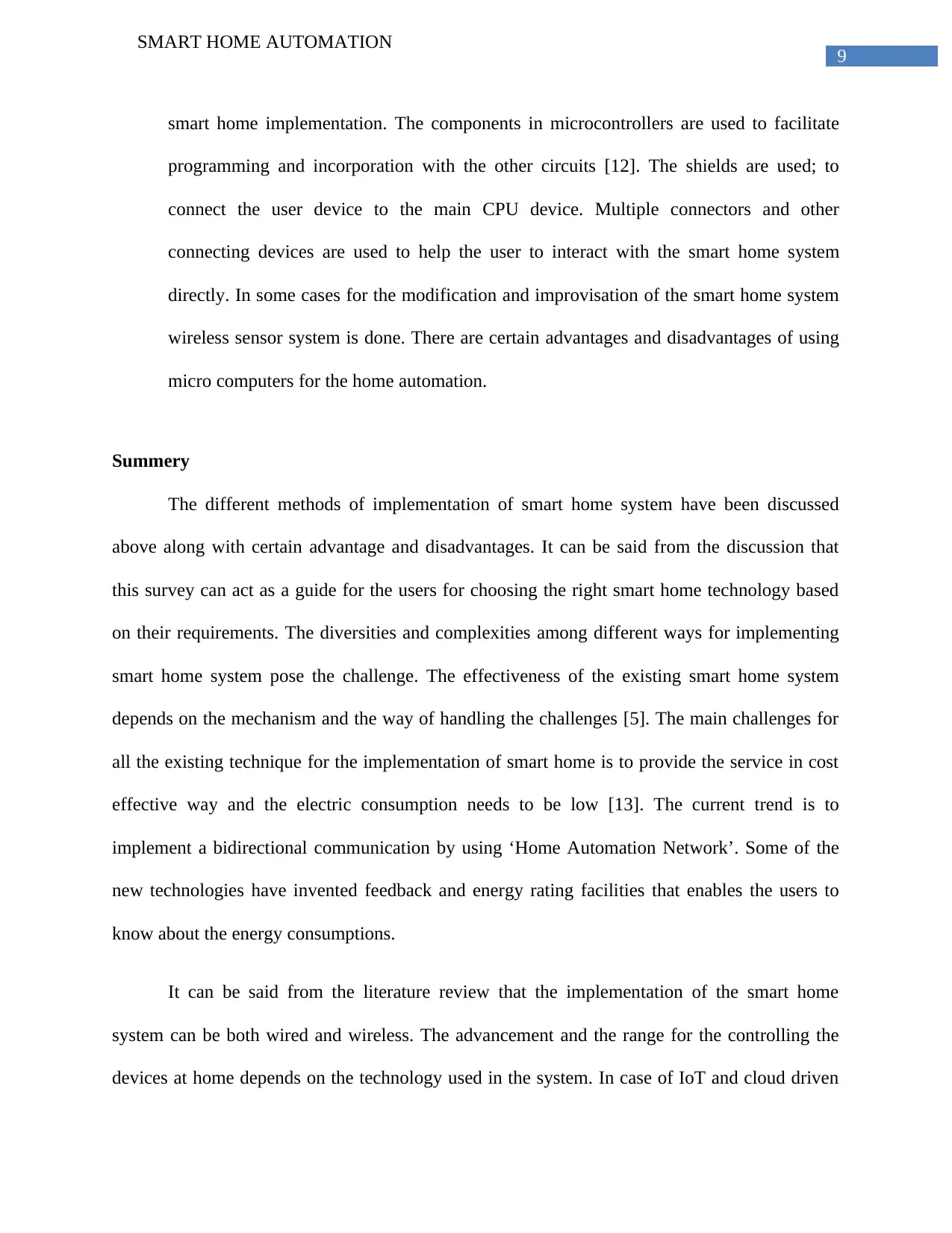
9
SMART HOME AUTOMATION
smart home implementation. The components in microcontrollers are used to facilitate
programming and incorporation with the other circuits [12]. The shields are used; to
connect the user device to the main CPU device. Multiple connectors and other
connecting devices are used to help the user to interact with the smart home system
directly. In some cases for the modification and improvisation of the smart home system
wireless sensor system is done. There are certain advantages and disadvantages of using
micro computers for the home automation.
Summery
The different methods of implementation of smart home system have been discussed
above along with certain advantage and disadvantages. It can be said from the discussion that
this survey can act as a guide for the users for choosing the right smart home technology based
on their requirements. The diversities and complexities among different ways for implementing
smart home system pose the challenge. The effectiveness of the existing smart home system
depends on the mechanism and the way of handling the challenges [5]. The main challenges for
all the existing technique for the implementation of smart home is to provide the service in cost
effective way and the electric consumption needs to be low [13]. The current trend is to
implement a bidirectional communication by using ‘Home Automation Network’. Some of the
new technologies have invented feedback and energy rating facilities that enables the users to
know about the energy consumptions.
It can be said from the literature review that the implementation of the smart home
system can be both wired and wireless. The advancement and the range for the controlling the
devices at home depends on the technology used in the system. In case of IoT and cloud driven
SMART HOME AUTOMATION
smart home implementation. The components in microcontrollers are used to facilitate
programming and incorporation with the other circuits [12]. The shields are used; to
connect the user device to the main CPU device. Multiple connectors and other
connecting devices are used to help the user to interact with the smart home system
directly. In some cases for the modification and improvisation of the smart home system
wireless sensor system is done. There are certain advantages and disadvantages of using
micro computers for the home automation.
Summery
The different methods of implementation of smart home system have been discussed
above along with certain advantage and disadvantages. It can be said from the discussion that
this survey can act as a guide for the users for choosing the right smart home technology based
on their requirements. The diversities and complexities among different ways for implementing
smart home system pose the challenge. The effectiveness of the existing smart home system
depends on the mechanism and the way of handling the challenges [5]. The main challenges for
all the existing technique for the implementation of smart home is to provide the service in cost
effective way and the electric consumption needs to be low [13]. The current trend is to
implement a bidirectional communication by using ‘Home Automation Network’. Some of the
new technologies have invented feedback and energy rating facilities that enables the users to
know about the energy consumptions.
It can be said from the literature review that the implementation of the smart home
system can be both wired and wireless. The advancement and the range for the controlling the
devices at home depends on the technology used in the system. In case of IoT and cloud driven
Paraphrase This Document
Need a fresh take? Get an instant paraphrase of this document with our AI Paraphraser
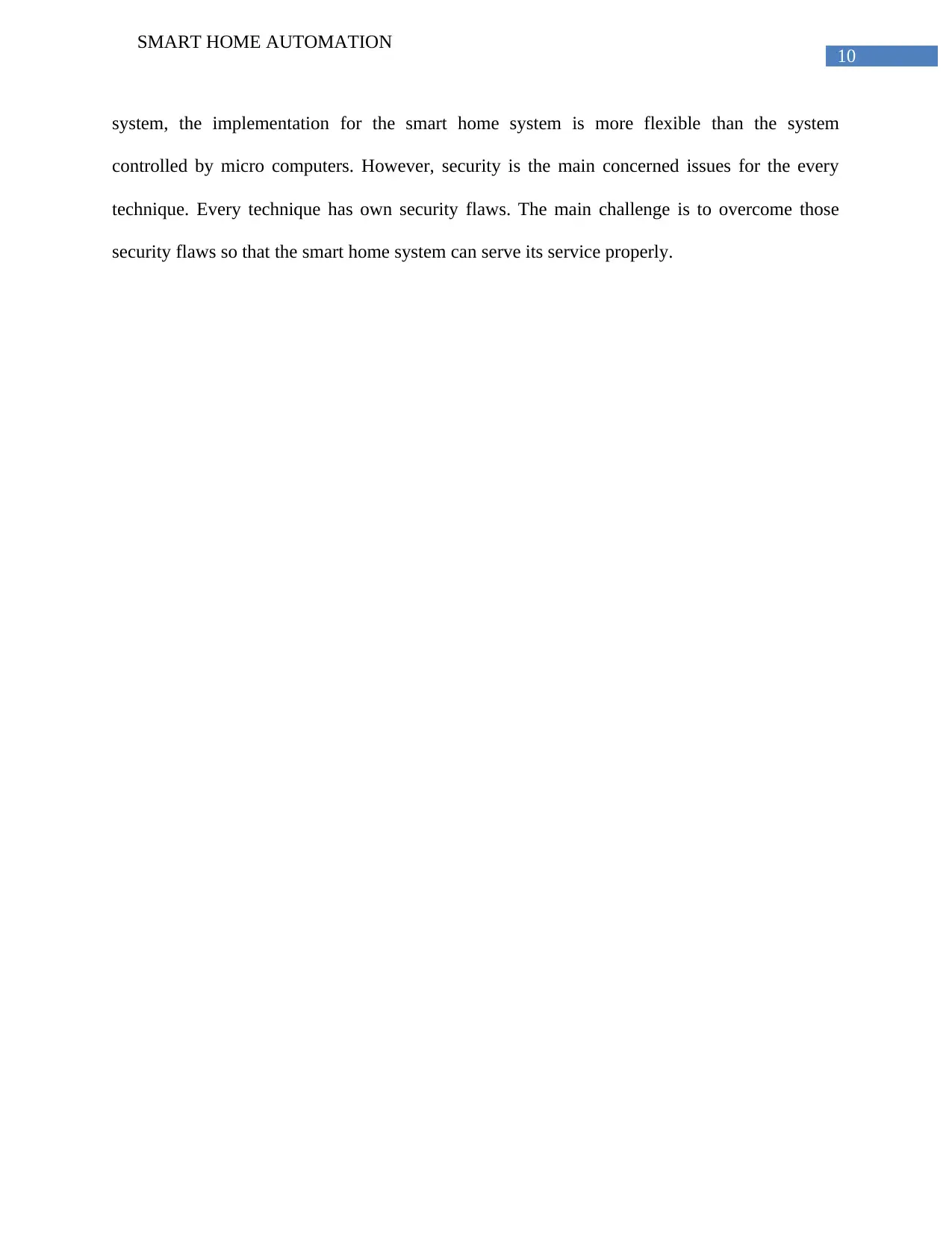
10
SMART HOME AUTOMATION
system, the implementation for the smart home system is more flexible than the system
controlled by micro computers. However, security is the main concerned issues for the every
technique. Every technique has own security flaws. The main challenge is to overcome those
security flaws so that the smart home system can serve its service properly.
SMART HOME AUTOMATION
system, the implementation for the smart home system is more flexible than the system
controlled by micro computers. However, security is the main concerned issues for the every
technique. Every technique has own security flaws. The main challenge is to overcome those
security flaws so that the smart home system can serve its service properly.
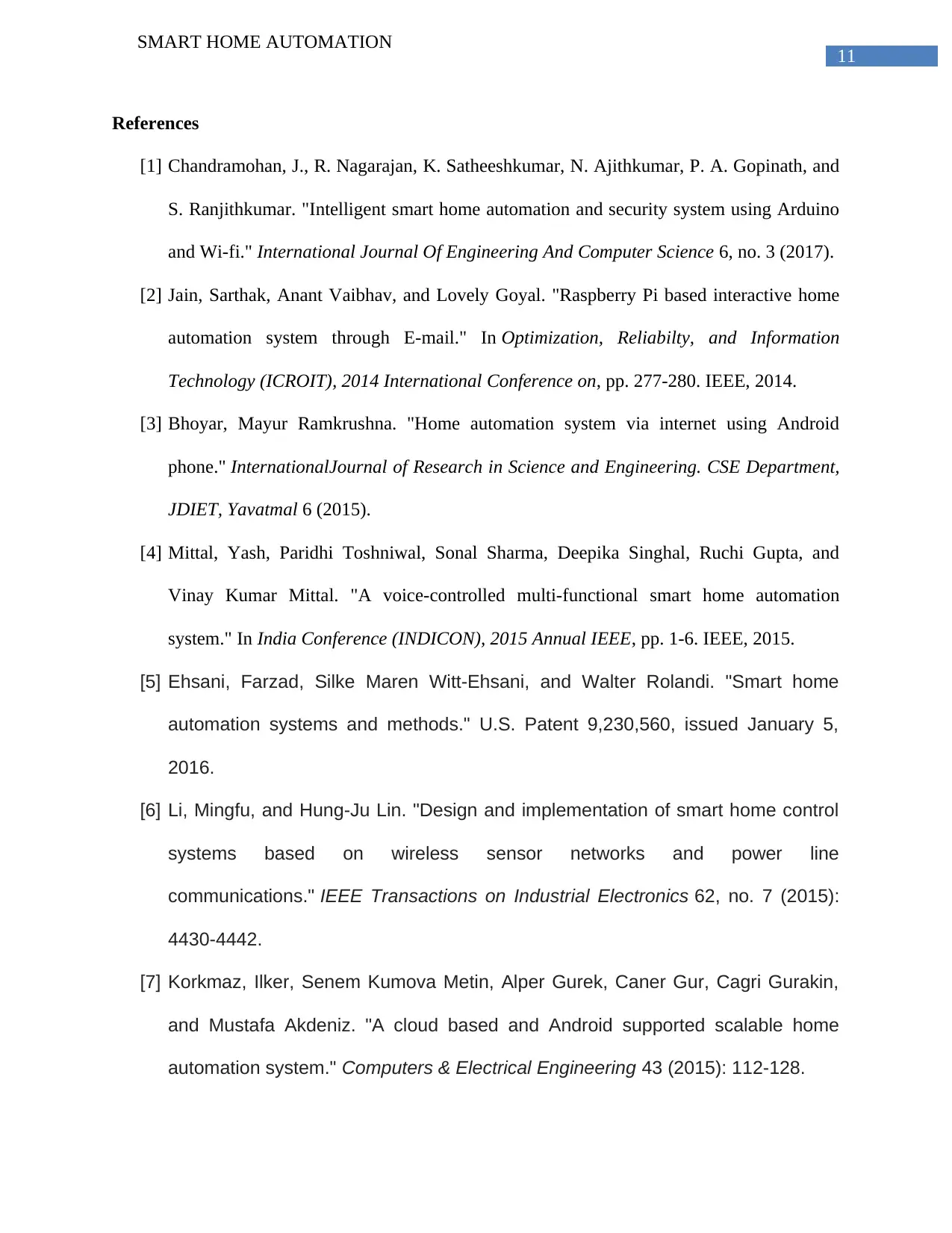
11
SMART HOME AUTOMATION
References
[1] Chandramohan, J., R. Nagarajan, K. Satheeshkumar, N. Ajithkumar, P. A. Gopinath, and
S. Ranjithkumar. "Intelligent smart home automation and security system using Arduino
and Wi-fi." International Journal Of Engineering And Computer Science 6, no. 3 (2017).
[2] Jain, Sarthak, Anant Vaibhav, and Lovely Goyal. "Raspberry Pi based interactive home
automation system through E-mail." In Optimization, Reliabilty, and Information
Technology (ICROIT), 2014 International Conference on, pp. 277-280. IEEE, 2014.
[3] Bhoyar, Mayur Ramkrushna. "Home automation system via internet using Android
phone." InternationalJournal of Research in Science and Engineering. CSE Department,
JDIET, Yavatmal 6 (2015).
[4] Mittal, Yash, Paridhi Toshniwal, Sonal Sharma, Deepika Singhal, Ruchi Gupta, and
Vinay Kumar Mittal. "A voice-controlled multi-functional smart home automation
system." In India Conference (INDICON), 2015 Annual IEEE, pp. 1-6. IEEE, 2015.
[5] Ehsani, Farzad, Silke Maren Witt-Ehsani, and Walter Rolandi. "Smart home
automation systems and methods." U.S. Patent 9,230,560, issued January 5,
2016.
[6] Li, Mingfu, and Hung-Ju Lin. "Design and implementation of smart home control
systems based on wireless sensor networks and power line
communications." IEEE Transactions on Industrial Electronics 62, no. 7 (2015):
4430-4442.
[7] Korkmaz, Ilker, Senem Kumova Metin, Alper Gurek, Caner Gur, Cagri Gurakin,
and Mustafa Akdeniz. "A cloud based and Android supported scalable home
automation system." Computers & Electrical Engineering 43 (2015): 112-128.
SMART HOME AUTOMATION
References
[1] Chandramohan, J., R. Nagarajan, K. Satheeshkumar, N. Ajithkumar, P. A. Gopinath, and
S. Ranjithkumar. "Intelligent smart home automation and security system using Arduino
and Wi-fi." International Journal Of Engineering And Computer Science 6, no. 3 (2017).
[2] Jain, Sarthak, Anant Vaibhav, and Lovely Goyal. "Raspberry Pi based interactive home
automation system through E-mail." In Optimization, Reliabilty, and Information
Technology (ICROIT), 2014 International Conference on, pp. 277-280. IEEE, 2014.
[3] Bhoyar, Mayur Ramkrushna. "Home automation system via internet using Android
phone." InternationalJournal of Research in Science and Engineering. CSE Department,
JDIET, Yavatmal 6 (2015).
[4] Mittal, Yash, Paridhi Toshniwal, Sonal Sharma, Deepika Singhal, Ruchi Gupta, and
Vinay Kumar Mittal. "A voice-controlled multi-functional smart home automation
system." In India Conference (INDICON), 2015 Annual IEEE, pp. 1-6. IEEE, 2015.
[5] Ehsani, Farzad, Silke Maren Witt-Ehsani, and Walter Rolandi. "Smart home
automation systems and methods." U.S. Patent 9,230,560, issued January 5,
2016.
[6] Li, Mingfu, and Hung-Ju Lin. "Design and implementation of smart home control
systems based on wireless sensor networks and power line
communications." IEEE Transactions on Industrial Electronics 62, no. 7 (2015):
4430-4442.
[7] Korkmaz, Ilker, Senem Kumova Metin, Alper Gurek, Caner Gur, Cagri Gurakin,
and Mustafa Akdeniz. "A cloud based and Android supported scalable home
automation system." Computers & Electrical Engineering 43 (2015): 112-128.
⊘ This is a preview!⊘
Do you want full access?
Subscribe today to unlock all pages.

Trusted by 1+ million students worldwide
1 out of 18
Related Documents
Your All-in-One AI-Powered Toolkit for Academic Success.
+13062052269
info@desklib.com
Available 24*7 on WhatsApp / Email
![[object Object]](/_next/static/media/star-bottom.7253800d.svg)
Unlock your academic potential
Copyright © 2020–2025 A2Z Services. All Rights Reserved. Developed and managed by ZUCOL.




